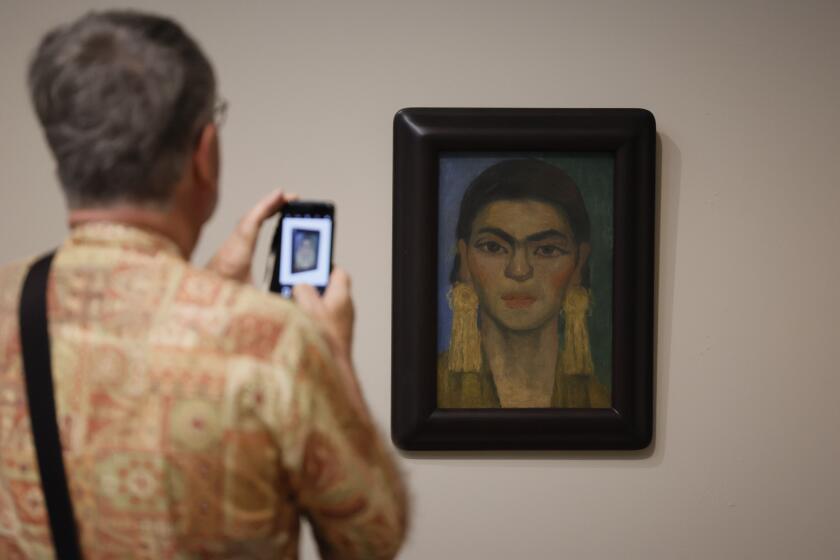‘Days of Punk’ Captures Chaotic Time and Place
At Track 16 Gallery, “Forming: The Early Days of L.A. Punk” charts (to steal a phrase from Situationist filmmaker Guy Debord) the passage of a few people during a rather brief moment in time. So brief, in fact, that by the time the mainstream music industry picked up L.A. punk on its radar screen, this iconoclastic “anti-movement” already had beaten a hasty retreat.
How, then, does one go about organizing a punk-rock retrospective when punk’s central object--the music itself, heard live in dank, stinky clubs like the Masque or the Hong Kong Cafe--no longer exists in its original context? How do you reconstruct a watershed cultural moment that had to be lived through to be truly understood?
Exhibition curators John Roecker, Exene Cervenka, Kristine McKenna, Pilar Perez, Susan Martin and Viggo Mortensen have made “Forming” first and foremost a fan’s exhibition, filling it with objects that only the truly devoted would bother saving: battered demo tapes, telephone pole fliers, scrawled set lists, the Masque’s banged-up and graffiti-strewn door, Cervenka’s fake diamond tiara, even stray candy wrappers.
The exhibition is structured around a series of memorabilia-covered, shrine-like wall installations and historical timelines (written by Roecker and Sherri Schott-laender), which give the gallery the chaotic feel of a teenager’s bedroom. Former club owner and current KROQ-FM (106.7) deejay Rodney Bingenheimer (the Dick Clark of L.A.’s alternative music scene) gets star treatment, along with trailblazing punk bands X, Black Flag, Fear, the Germs and countless others.
What makes this exhibition much more than a trip down memory lane, however, is its organizers’ successful efforts to situate punk in terms of other alternative cultural practices in L.A. at the time. The inclusion of elaborate collage-diaries by Cervenka (which themselves embody punk’s signature cut-and-paste aesthetic), Black Flag album cover illustrations by Raymond Pettibon and photographs of way out-there performances by Viennese Actionist Hermann Nitsch, the Kipper Kids and Johanna Went, makes the cross-pollination between the worlds of art and punk explicit.
Incisive catalog essays by McKenna and Sean Carillo provide overviews of punk aesthetics and the importance of East L.A. to the punk scene, respectively. McKenna also makes crucial connections between punk and its Dada and Situationist precursors, while Carillo foregrounds the links between punk culture and related goings-on at art venues like LACE, LAICA, Self-Help Graphics and Beyond Baroque.
For an “anti-movement” that prided itself on its outsider status, the punk scene fostered a remarkably strong sense of community among its inner core. Corny as it sounds, this sense of belonging is probably what makes punk most worth remembering for those disaffected outcasts, many of whom, over two decades later, have highly regarded careers as artists, curators, actors, journalists and graphic designers.
* Track 16 Gallery, Bergamot Station, 2525 Michigan Ave., Santa Monica, (310) 264-4678, through June 5. Closed Sundays and Mondays.
*
Ambi-Artistic: Although she is right-handed, Seattle-based artist Pam Keeley draws with both hands at once, an unusual technique that combines controlled lines and shading with looser forms of gestural improvisation. At Gallery Soolip, Keeley’s spindly pencil lines unwind like spools of thread cast across wheat or cream-colored sheets of paper. Her mixed-media drawings and paintings recall the art of children or the insane, at times rather self-consciously so.
Androgynous, wraith-like figures, disembodied heads and hollow-eyed visages emerge, sometimes just barely, only to trail off once again into incoherent scratches and scrawls. Some are blotted out with white, cream, or pink paint; others are smudged or partially erased.
These peculiar beings appear at once aged and infantile, male and female. Sometimes, several figures are connected by a thin, umbilical-like tendril, other times a single body holds two people at once, like Siamese twins.
Despite--or perhaps because of--all the smears, scribbly lines, erasures, blots and diffident scrawls, Keeley’s drawings feel somewhat overly refined, the messiness carefully stylized to achieve maximum aphasiac effect. This is only heightened by the artist’s heavy-handed incorporation of textual wordplay.
Phrases freighted with social import, such as “social security,” “turn of the century” or “pledge of allegiance” are stenciled across the drawings and then partially painted out to reveal new words and meanings. From “pledge of allegiance,” for example, Keeley locates “paean,” “fag” and “lie,” among other loaded terms. Similarly, the phrase “legal tender” yields words like “lend,” “alter” and “lead.”
Although these anagrams tease out the ironic and rebellious double-meanings within seemingly monolithic concepts, the results are hardly earth-shattering. They add only clunkiness to Keeley’s otherwise nimble drawings, which are compelling enough on their own without such dated Postmodern preciousness.
* Gallery Soolip, 8646 Melrose Ave., West Hollywood, (310) 360-0154, through May 22. Closed Sundays, Mondays and Tuesdays.
*
Lands of Plenty: Painter Rebecca Morales takes as her subject matter the flora and fauna of the desert, which will seem like a contradiction in terms only to those who wrongly assume that “desert” automatically equals desiccated wasteland. Morales knows otherwise. In her impressive solo debut at Koplin Gallery, Morales’ 10 new landscape paintings, each made in 1999, portray semi-arid desert regions as thriving ecosystems that are as varied, vibrant and colorful as any other.
Morales paints what she calls “carpets of land”: flattish, depopulated expanses stubbled with scrubby succulent plants and smoke trees, creosote bushes, cholla cacti and Artemesia plants. Seen from a distance, one could easily mistake Morales’ finely detailed, oil on aluminum panel paintings for photographs. Up close, however, the plants and brush appear slightly blurred, as if fluffed by a gentle breeze.
Although these works are panoramic in scope (the smallest is 10 1/2 inches tall and 30 inches wide and the largest 30 inches tall and 90 inches wide), they are intimate in scale. Morales doesn’t organize her landscapes around a particular landmark or other centralizing focal point, making these paintings far more demanding than typical landscape fare.
There are no “stunning vistas” here, nothing to do the work for you. Morales has faith in the beauty and integrity of these plain-spoken desert landscapes. She invites you to explore every inch of her paintings’ surfaces, particularly at the foreground of the compositions, which are rife with detail.
Rounding out this quiet and unpretentious show are three of Morales’ startlingly lifelike paintings of dead birds, snakes and mice, which are captured in the midst of their struggle to kill and thus to survive. Here, Morales displays a miniaturist’s eye for precise detail, a skill that puts the kitschy trompe l’oeil genre to its best use.
* Koplin Gallery, 464 N. Robertson Blvd., Los Angeles, (310) 657-9843, through May 29. Closed Mondays and Tuesdays.
*
Rashomon On: “Percipient Witness,” Liza Ryan’s fourth solo show at Griffin Contemporary Exhibitions, explores a common phenomenon in which two or more witnesses to the same event will relate very different accounts of it. Under such circumstances, can the event still be described as singular? Or, does it instead shatter into as many pieces as there are witnesses, each shard reflecting an individual set of perceptions and emotions?
Consisting of single images and sequentially arranged, elliptical photo-narratives, Ryan’s six new works connect the act of witnessing to the highly individualistic ways in which different viewers perceive the same work of art. Her best images lavish attention on ordinary objects, relying on extreme close-up views that encourage intimate scrutiny on the part of viewers.
A triad of color chromogenic prints zero in on the backs of people’s necks, revealing every freckle and blemish, each strand of hair, even the tiny goosebumps that arise in response to a gentle breeze brushing across exposed skin. There’s a palpable sensuality to these photographs, whose subjects bare their vulnerable flesh as if submitting to a lover’s long, lingering gaze. In another close-up image, the heels on a pair of muddy black boots wear their scratches, cracks and abrasions like battle scars.
Unlike most photographers influenced by Conceptual art, Ryan isn’t afraid to craft good-looking images; nor does she strive for the Conceptualist’s typical frosty remove.
Unfortunately, Ryan does feel the need to inscribe fragmentary text across several of the photographs’ glass frames. For example, appearing across an image of heavy orange curtains are the words “long / short / accept /deny / conscious / unconscious.”
Although Ryan’s addition of text is presumably meant to highlight opposing interpretations of a single image or event, the tactic doesn’t really add anything but clutter. The images suit her purpose far better when unmoored from linguistic description, however poetic.
*
* Griffin Contemporary Exhibitions, 915 Electric Ave., Venice, (310) 452-1014, through May 29. Closed Sundays and Mondays.
More to Read
The biggest entertainment stories
Get our big stories about Hollywood, film, television, music, arts, culture and more right in your inbox as soon as they publish.
You may occasionally receive promotional content from the Los Angeles Times.






